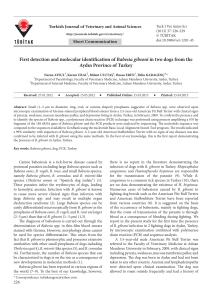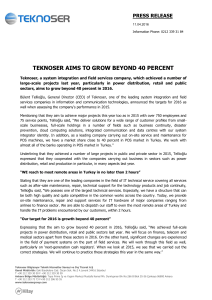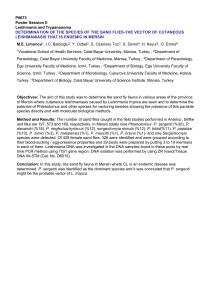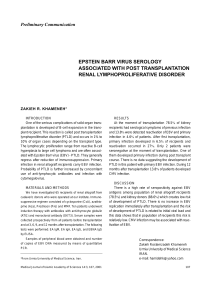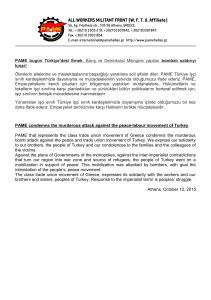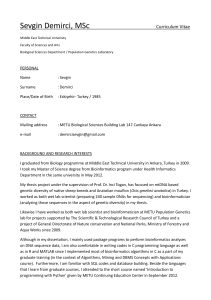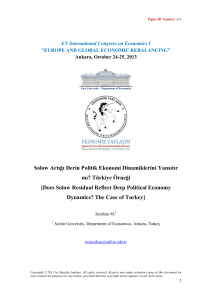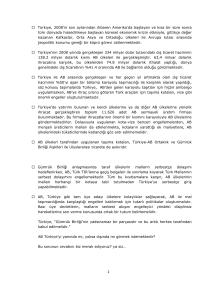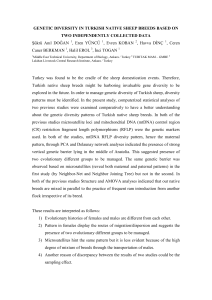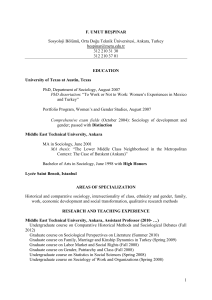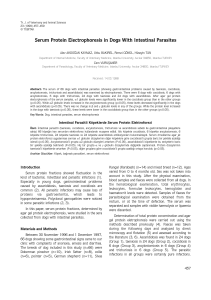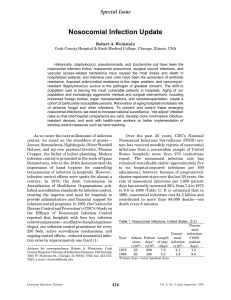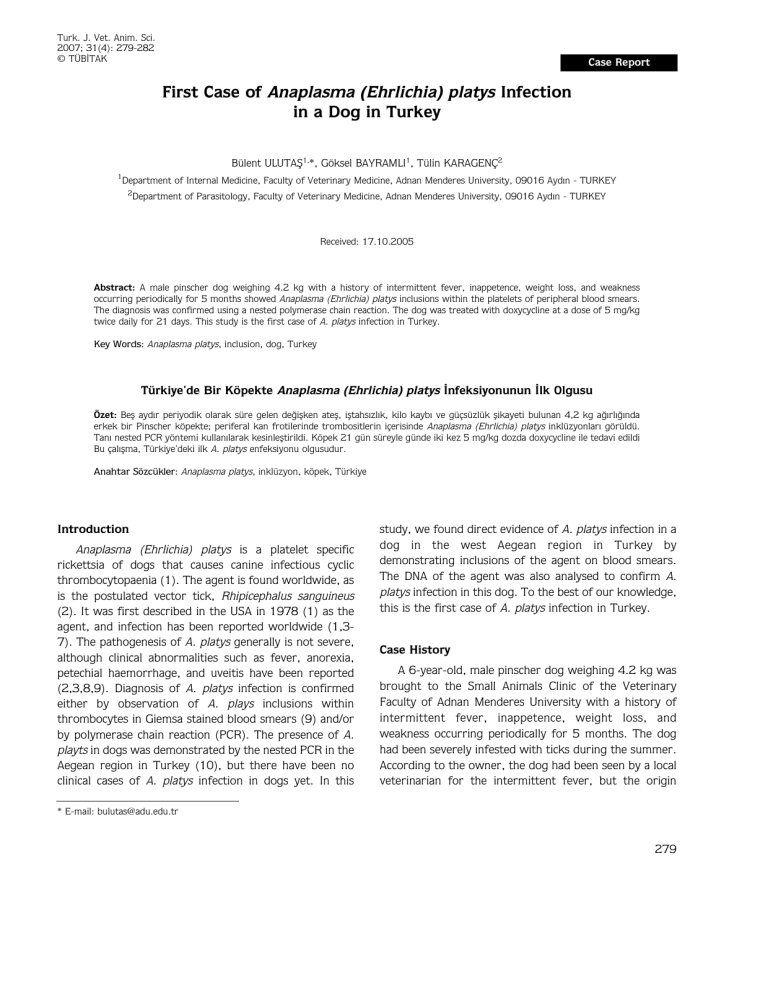
Turk. J. Vet. Anim. Sci.
2007; 31(4): 279-282
© TÜB‹TAK
Case Report
First Case of Anaplasma (Ehrlichia) platys Infection
in a Dog in Turkey
Bülent ULUTAfi1,*, Göksel BAYRAMLI1, Tülin KARAGENÇ2
1
Department of Internal Medicine, Faculty of Veterinary Medicine, Adnan Menderes University, 09016 Ayd›n - TURKEY
2
Department of Parasitology, Faculty of Veterinary Medicine, Adnan Menderes University, 09016 Ayd›n - TURKEY
Received: 17.10.2005
Abstract: A male pinscher dog weighing 4.2 kg with a history of intermittent fever, inappetence, weight loss, and weakness
occurring periodically for 5 months showed Anaplasma (Ehrlichia) platys inclusions within the platelets of peripheral blood smears.
The diagnosis was confirmed using a nested polymerase chain reaction. The dog was treated with doxycycline at a dose of 5 mg/kg
twice daily for 21 days. This study is the first case of A. platys infection in Turkey.
Key Words: Anaplasma platys, inclusion, dog, Turkey
Türkiye’de Bir Köpekte Anaplasma (Ehrlichia) platys ‹nfeksiyonunun ‹lk Olgusu
Özet: Befl ayd›r periyodik olarak süre gelen de¤iflken atefl, ifltahs›zl›k, kilo kayb› ve güçsüzlük flikayeti bulunan 4,2 kg a¤›rl›¤›nda
erkek bir Pinscher köpekte; periferal kan frotilerinde trombositlerin içerisinde Anaplasma (Ehrlichia) platys inklüzyonlar› görüldü.
Tan› nested PCR yöntemi kullan›larak kesinlefltirildi. Köpek 21 gün süreyle günde iki kez 5 mg/kg dozda doxycycline ile tedavi edildi
Bu çal›flma, Türkiye’deki ilk A. platys enfeksiyonu olgusudur.
Anahtar Sözcükler: Anaplasma platys, inklüzyon, köpek, Türkiye
Introduction
Anaplasma (Ehrlichia) platys is a platelet specific
rickettsia of dogs that causes canine infectious cyclic
thrombocytopaenia (1). The agent is found worldwide, as
is the postulated vector tick, Rhipicephalus sanguineus
(2). It was first described in the USA in 1978 (1) as the
agent, and infection has been reported worldwide (1,37). The pathogenesis of A. platys generally is not severe,
although clinical abnormalities such as fever, anorexia,
petechial haemorrhage, and uveitis have been reported
(2,3,8,9). Diagnosis of A. platys infection is confirmed
either by observation of A. plays inclusions within
thrombocytes in Giemsa stained blood smears (9) and/or
by polymerase chain reaction (PCR). The presence of A.
playts in dogs was demonstrated by the nested PCR in the
Aegean region in Turkey (10), but there have been no
clinical cases of A. platys infection in dogs yet. In this
study, we found direct evidence of A. platys infection in a
dog in the west Aegean region in Turkey by
demonstrating inclusions of the agent on blood smears.
The DNA of the agent was also analysed to confirm A.
platys infection in this dog. To the best of our knowledge,
this is the first case of A. platys infection in Turkey.
Case History
A 6-year-old, male pinscher dog weighing 4.2 kg was
brought to the Small Animals Clinic of the Veterinary
Faculty of Adnan Menderes University with a history of
intermittent fever, inappetence, weight loss, and
weakness occurring periodically for 5 months. The dog
had been severely infested with ticks during the summer.
According to the owner, the dog had been seen by a local
veterinarian for the intermittent fever, but the origin
* E-mail: bulutas@adu.edu.tr
279
First Case of Anaplasma (Ehrlichia) platys Infection in a Dog in Turkey
could not be determined. Intramuscular gentamicin at a
dose of 4 mg/kg was given to the dog by the veterinarian.
On the day of presentation, the dog appeared to be
depressed and emaciated. The physical examination also
revealed weakness, peripheral lymphadenopathy, pale
mucosal membranes, and a normal rectal temperature
(38.3 ºC). In the abnormal haematological findings,
packed cell volume was 20.8% (normal range 37%12
55%), red blood cell (RBC) count was 3.05 × 10 RBCs/l
12
(normal range 5.50-8.50 × 10 RBCs/l), white blood cell
9
(WBC) was 33.2 × 10 WBCs/l (normal range 5.009
9
17.00 × 10 WBCs/l), platelet (PLT) count was 80 × 10
9
PLTs/l (normal range 200-500 × 10 PLTs/l), and mean
platelet volume was 12.9 fl (normal range 5.6-9.1 fl).
Results of serum biochemical analyses indicated low
glucose (2.7 mmol/l; normal range 3.4-6.0 mmol/l) and
albumin (21 g/l; normal range 25.8-39.7 g/l), and high
globulin (59 g/l; normal range 20.6-37.0 g/l)
concentrations. Aspartate amino-transferase (55 U/l;
normal range 8.9-48.5 U/l) and alkaline phosphatase
activities (120 U/l; normal range 10.6-100.7 U/l) were
slightly increased. Examination of blood smears revealed
the presence of A. platys basophilic inclusions in platelets
alone or clusters (Figure 1a-d). Only 9% of blood
platelets contained such inclusions. Some of these
infected platelets were larger than some of the
erythrocytes (Figure 1c,d). A nested PCR was performed
using EDTA-anticoagulated peripheral blood taken from
the cephalic vein in order to confirm the presence of
Anaplasma platys in the dog. DNA was extracted
following the Wizard genomic DNA isolation kit
(Promega, USA). A primer set, S8FE (5′- GGA ATT CAG
AGT TGG ATC MTG GYT CAG -3′) and B-GA1B (5′- CGG
GAT CCC GAG TTT GCC GGG ACT TCT -3′), which
amplify the 16S rRNA gene (11), was used in the first
round of PCR. This was followed by the second round
PCR using an A. platys-specific primer PLATYS-F (5′- AAG
TCG AAC GGA TTT TTG TCG TAG CTT -3) (12) with
some modification and an Ehrlichia genus-specific primer
HE3 (5-CTT-ATT-ATT-CCA-TGC-TGC-AG-3) (13). PCR
conditions were as described previously (12,13).
The dog was found to be free of other blood parasites
(Hepatozoon canis, Haemobartonella canis, Babesia spp.
and E. canis) upon examination of Giemsa-stained blood
smears. Leishmania antibodies, as determined by IFAT,
Figure 1a-d. Basophilic inclusions of A. platys within the platelets on peripheral blood smears from a dog.
280
B. ULUTAfi, G. BAYRAMLI, T. KARAGENÇ
were also absent. The dog was given 5 mg/kg doxycycline
(Monodox, Deva) twice daily for 21 days and responded
to the treatment within 48 h. No inclusions were
determined in blood platelets upon microscopic
examination of the smears during the second day’s
examination. The dog’s condition continued to improve
and the animal showed an improved tolerance to exercise
and an increased appetite, but had mild anaemia 21 days
after the treatment. Bodyweight had increased to 4.7 kg.
Therefore, haematological and biochemical analyses were
performed for 16 weeks for a possible relapse.
Moreover, the thrombocytopaenia determined before
treatment was no longer observed.
Results and Discussion
Although canine A. platys infection in Turkey has been
demonstrated by nested PCR before, there have not been
any clinical case reports of A. platys infection in dogs.
Thus the pathogenesis of A. platys in Turkey is unknown.
In this study, we found direct evidence of A. platys
infection in a dog in the west Aegean region in Turkey by
demonstrating inclusions of the agent on blood smears.
The DNA of the agent was also analysed to confirm the A.
platys infection in the dog. To detect A. platys inclusions
on the smears of peripheral blood is known to be difficult
and time consuming, because inclusions usually occur
transiently and in low numbers (2). Inokuma et al. (6)
demonstrated that 1 of 6 A. platys infected dogs had
inclusions in peripheral blood platelets and 5% of the
platelets had such inclusions. On the day of presentation,
in the dog described here, 9% of the platelets had
inclusions. Acute A. platys infection is characterised by a
parasitaemia of platelets followed by episodes of
thrombocytopaenia that occur cyclically at 7- to 14-day
intervals (1). Most reports have indicated that infected
dogs are generally not affected clinically and rarely show
signs of significant haemorrhage even with platelet
counts as low as 20 × 109/l or less. Within a few days the
platelet count begins to rise again to normal levels only to
fall again 1 to 2 weeks later (14). In the present case,
according to the history, the dog had shown some of the
clinical symptoms such as intermittent fever, weakness,
and inappetence and transient recovery 4 times in 5
months, periodically. In accordance with previous reports
(1,3-5), marked thrombocytopaenia was determined in
this case before the treatment. Furthermore, anaemia—
a non-specific finding for A. platys infection—was also
determined. This situation could be explained by the
chronic inflammatory condition as reported previously
(8,15). In conclusion, this is the first case of A. platys
infection in a dog in Turkey.
References
1.
Harvey, J.W., Simpson, C.F., Gaskin, J.M.: Cyclic
thrombocytopenia induced by a Rickettsia-like agent in dogs. J.
Infect. Dis., 1978; 137: 182-188.
2.
Hoskins, J.D.: Ehrlichial diseases of dogs: diagnosis and
treatment. Canine Pract., 1991; 16: 13-21.
3.
Baker, D.C., Simpson, M., Gaunt, S.D., Corstvet, R.E.: Acute
Ehrlichia platys infection in the dog. Vet. Pathol., 1987; 24: 449453.
4.
Kontos, V.I., Papadopoulos, O., French, T.W.: Natural and
experimental canine infections with a Greek strains of Ehrlichia
platys. Vet. Clin. Pathol., 1991; 20: 101-105.
5.
Sainz, A., Amusategui, I., Tesouro, M.A.: Ehrlichia platys infection
and disease in dogs in Spain. J. Vet. Diagn. Invest., 1999; 11:
382-384.
6.
Inokuma, H., Fujii, K., Matsumoto, K., Okuda, M., Nakagome, K.,
Kosugi, R., Hirakawa, M., Onishi, T.: Demonstration of
Anaplasma (Ehrlichia) platys inclusions in peripheral blood
platelets of a dog in Japan. Vet. Parasitol., 2002; 110: 145-152.
7.
Beaufils, J.P., Inokuma, H., Martin-Granel, J., Jumelle, P.,
Barbault-Jumelle, M., Brouqui, P.: Anaplasma platys (Ehrlichia
platys) infection in a dog in France: description of the case, and
characterization of the agent. Rev. Méd. Vét., 2002; 153: 85-90.
8.
Glaze, M.B., Gaunt, S.D.: Uveitis associated with Ehrlcihia platys
infection in a dog. J. Am. Vet. Med. Assoc., 1986; 188: 916-917.
9.
Bradfield, J.F., Vore, S.J., Pyror, W.H.: Ehrlichia platys infection
in dogs. Lab. Anim. Sci., 1996; 46: 565-568.
10.
Karagenc, T., Hosgor, M., Bilgic, H.B., Pasa, S., Kırlı, G., Eren,
H.: Detection of prevalence of E. canis, A. phagocytophila and A.
platys in dogs around the Aegean coast of Turkey by using a
nested PCR. XIV National Parasitology Congress, 18-25
September 2005, ‹zmir.
11.
Oura, C.A.L., Bishop, R.P., Wampande, E.M., Lubega, G.W., Tait,
A.: Application of a reverse line blot assay to the study of
haemoparasites in cattle in Uganda. Int. J. Parasitol., 2004; 34:
603-613.
281
First Case of Anaplasma (Ehrlichia) platys Infection in a Dog in Turkey
12.
13.
282
Inokuma, H., Ohno, K., Onishi, T., Raoult, D., Brouqui, P.:
Detection of ehrlichial infection by PCR in dogs from Yamaguchi
and Okinawa Prefectures, Japan. J. Vet. Med. Sci., 2001; 63:
815-817.
Murphy, G.L., Ewing, S.A., Whitworth, L.C., Fox, J.C., Kocan,
A.A.: A molecular and serologic survey of Ehrlichia canis, E.
chaffeensis and E. ewingii in dogs and ticks from Oklahoma. Vet.
Parasitol., 1998; 79: 325-339.
14.
Stiles, J.: Canine rickettsial infections. Vet. Clin. North Am. Small
Anim. Pract., 2000; 30: 1135-1149.
15.
Baker, D.C., Gaunt, S.D., Babin, S.S.: Anemia of inflammation in
dogs infected with Ehrlichia platys. Am. J. Vet. Res., 1988; 49:
1014-1016.

